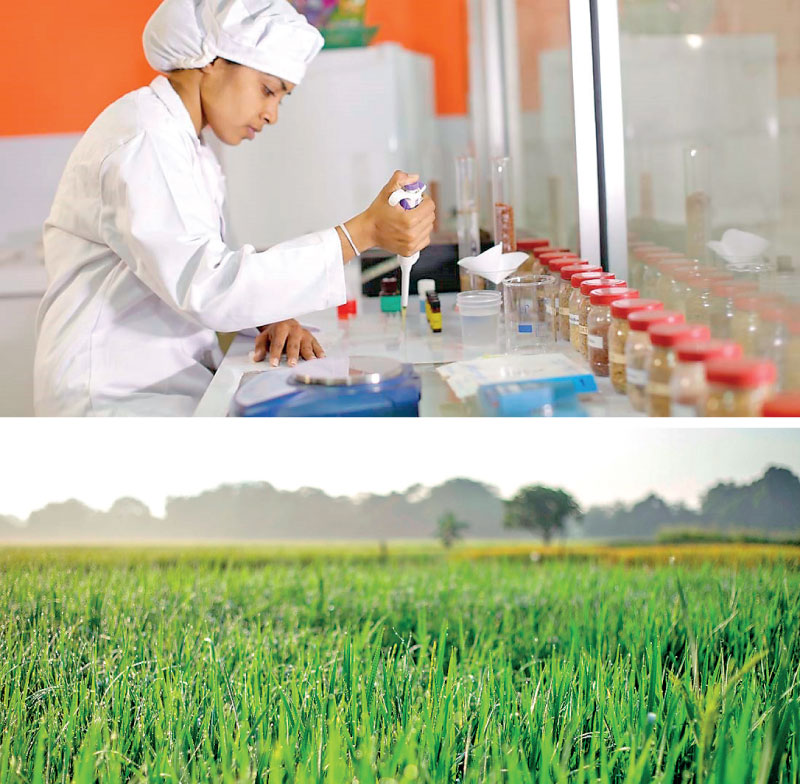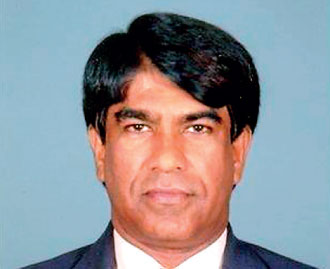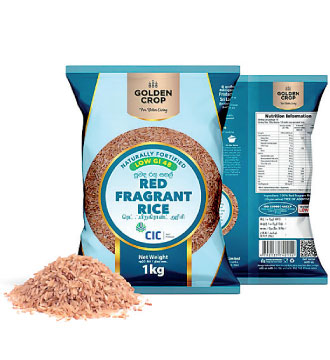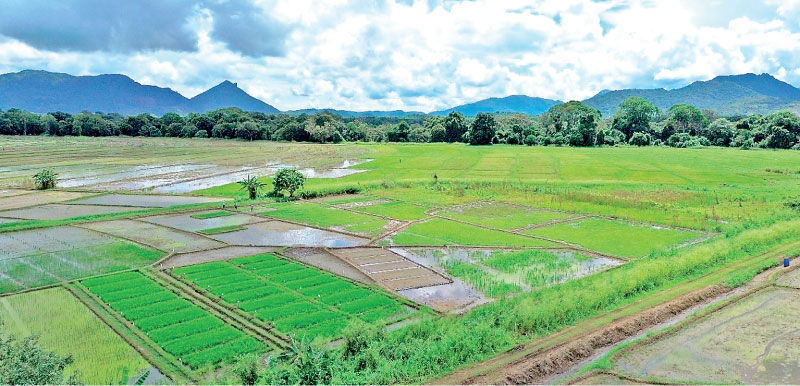Saturday Mar 29, 2025
Saturday Mar 29, 2025
Thursday, 16 January 2025 02:11 - - {{hitsCtrl.values.hits}}

By Marlon Fernandopulle
 |
| Dr. Sumith de Z. Abeysiriwardena |
 |
Driven by the passion for research and the thirst for innovation, a Sri Lankan rice scientist through a blend of curiosity, dedication and unwavering commitment spent hours in the humid and scorching rice fields in Dambulla and the laboratories to finally come up with what most of us relish today as tasty, slender and healthy Red Basmathi Rice. The unique innovation carried out after three years of meticulous research in the fields and laboratories resulted in the world’s first red basmathi type rice developed in Sri Lanka.
The scientist behind this world’s first innovation is Dr. Sumith de Z Abeysiriwardena, a former Director of the Rice Research Institute (RRI) in Batalagoda and currently a Consultant on Rice Research and Development at CIC Agri Businesses. The Daily FT caught up with Dr. Abeysiriwardena for a detailed insight to this historic innovation.
The innovation of these rice varieties over the years by Dr. Sumith Abeysiriwardene is truly commendable and stands as a testament to the power of innovation that Lankan Scientists do possess. By reducing the dependency on imported rice, it has also played a crucial role in conserving foreign exchange. Moreover, its contribution to the well-being of citizens is immeasurable, as it not only ensures food security but also uplifts the health and nutrition standards across communities. This remarkable achievement exemplifies how forward-thinking agricultural advancements can drive holistic development, benefiting both the economy and the people.
Dr. Sumith Abeysiriwardene, an agriculture graduate from the University of Peradeniya completed his Masters in Agronomy and PhD in Plant Breeding from Virginia University (USA). He has received many accolades both local and internationally for his academic work and research papers. His innovation that led to the Red Basmathi type rice and Red Fragrant rice has saved Sri Lanka from millions in foreign exchange.
In the interview he was indeed grateful to the former CIC Chairman B.R.L. Fernando for giving the opportunity to join CIC that enabled to make this great contribution to the Sri Lanka. “The challenge thrown at me by the former Chairman of CIC and his continuous guidance helped me in fulfilling my tasks,” said Dr Abeysiriwardene.
Here are excerpts.
Q: You have been credited with the innovation of the world’s first Red Basmathi type rice, is that correct?
Yes, Correct, this was almost 15 years ago.
Q: Can you recall the sequence of events that led to this great innovation?
After prematurely retiring as the Director of the Rice Research and Development Institute in Batalagoda, I joined CIC Agri Businesses in Feb., 2006 on the request of the former CIC Chairman B.R.L. Fernando. During that time only the public sector was involved in rice research. R. Fernando wanted me to initiate a rice research program at CIC to develop rice varieties with superior grain qualities that can compete with the imported ‘Basmathi’ type and ‘Jasmin’ rice.
Based on his request and his broad vision for Agriculture in Sri Lanka, I initiated a rice research program on developing rice varieties with indicated grain qualities at the CIC Seed farm in Pelwehera.
When I accepted Fernando’s invitation to join CIC, the first question he asked me was how long would it take to develop a new rice variety? Then I said at least 6 years. The Challenge he gave me was to develop a new variety as soon as possible.
I had earlier developed the first aromatic white long grain rice variety in Sri Lanka with grain quality somewhat similar to Basmati in 1994 at Ambalantota and recommended cultivation by the name ‘Lanka Samurdi’. However, it was a sticky rice that took 4 months to mature and so the farmer acceptance was very poor. Later on, I observed that a red long grain plant was rarely appearing
In ‘Lanka Samurdi’ populations usually such off types are discarded. Rarely occurring off-types may be natural mutants. One of the strategies in plant breeding is the making use of off-types which may be natural mutants so I thought of making use of this mutant as a solution for the challenge given.
As soon as I joined CIC, the first thing I did was that I planted a large population of ‘Lanka Samurdi’ in the CIC rice field in Pelwehera which was allocated for R&D and searched for the red mutant. Fortunately, I found two long grain red plants amongst the white grain ‘Lanka Samurdi’ population. This selection had long slender non-sticky red grains with very low but unique aroma and matured within three months. This was purified through further selection and named as ‘Red Basmathi’. This was the first Red Basmathi type rice variety developed in the world as all the basmathi rice in the world is white. (‘Basmathi’ is the name given in India for their specialty rice so that using the name Basmathi for our rice is illegal.)
After assuring that the ‘Red Basmathi’ type rice variety is a true pure line, it was multiplied in selected out grower farmer fields in adequate quantities and processed at the CIC rice mill in Maho. Finally, we were able to commercialise this ‘Red Basmathi’ type rice in the local market by 2009, within three years of initiating the rice research programme.
At present the red Basmathi type rice is commercialised in the local as well as in the International markets by the name ‘Whole Grain Red Rice’ without using the name Red Basmathi.
Q: Following the innovation of the red basmathi type rice was there any further innovations done?
Yes, we went one step further with the development of ‘Red Fragrant’ rice since the Red Basmathi type rice is not sufficiently aromatic. We wanted to incorporate several more health properties into the Red Basmathi type grains for export promotion. Thus, we were able to further improve red Basmathi type variety genetically by incorporating high aroma and more health properties to develop ‘Red Fragrant’ rice which is highly aromatic having long slender grains with additional health properties such as high protein, high vitamin B and lower GI (48) than that of Red Basmathi type, thus making it one of the most healthiest rice in the market. Red Fragrant was developed through conventional hybridisation and selection which is the scientific crop genetic improvement process. Red Fragrant is a fragrant long grain red rice variety where excellent health properties are combined with attractive cooking and eating qualities. Research on Red Fragrant was initiated in late 2008, completed in late 2012 and commercialised by early 2014.
After developing the two Red Basmathi type varieties, I also developed a few more rice varieties at CIC Agri Businesses. Namely White Slender (Aromatic White Basmathi type variety), Sudu Suduru (Small grain variety with high grain quality better than Keera Samba), Rathu Suduru (Samba variety with high grain quality similar to traditional Suduru Samba), Ceylon Purple Rice (First purple rice developed in Sri Lanka with high grain quality), Super kernel (Aromatic long slender grain variety very similar to Basmathi rice which is good to import substitution) and Savandara (Aromatic sticky rice similar to Jasmin rice)
Q: Are these rice varieties available in the local market?
Yes, they are freely available in the local super markets and are also exported to countries like Australia, Canada, USA, Middle East, Singapore etc. Due to the many health benefits of these rice varieties, they have a great demand in Sri Lanka and abroad.
Q: Apart from these ground-breaking rice innovations have you been involved in any other innovation of rice varieties?
Yes, during my tenure at the Department of Agriculture I was instrumental in developing six improved rice varieties. They are Bw 272-6b,Bw 267-3, Bw 266-7, Bw 351, and Bw 400 for cultivation in the Low Country Wet Zone of Sri Lanka which has problems with its soils. Bw 267-3 is tolerant to Fe toxicity and Bw 400 is tolerant to salinity. All these varieties are highly adaptable to ill- drained conditions. Bg 250 that matures within 80 days was also developed by me.
In addition I was also involved in developing an improved high yielding Basmathi type quality rice variety named ‘ Lanka Samurdi’ in 1994 where Basmathi quality is combined with improved short plant type. This is the first high yielding Basmathi type (White) quality and sticky rice variety with an improved plant type to have been developed in Sri Lanka.
Q: What is the future of Rice Research in Sri Lanka? And what do you expect the new Government to do in this regard?
The Government policy with respect to rice should be focused to increase rice productivity and production, import substitution and export promotion while maximising the utilisation of natural resources available in the country. In order to achieve this Rice research should be given high priority, Infrastructure facilities and human resource requirements for research should be adequately provided and adequate funding should be allocated.
At present, rice research is basically in the hands of the public sector. Private sector should also be encouraged in research. Private sector should be given responsibility to conduct independent research but within Government regulations.
In terms of regulations the Plant Variety Protection Act should be immediately implemented in the country to encourage private sector investment on development of new rice varieties with high yields and grain quality. The Government should also recognise and appreciate the inventions of rice scientists.

(The writer is an Agriculture Graduate from the University of Peradeniya, and worked as the Director HR for a leading Agri Business Company in Sri Lanka.)
Discover Kapruka, the leading online shopping platform in Sri Lanka, where you can conveniently send Gifts and Flowers to your loved ones for any event including Valentine ’s Day. Explore a wide range of popular Shopping Categories on Kapruka, including Toys, Groceries, Electronics, Birthday Cakes, Fruits, Chocolates, Flower Bouquets, Clothing, Watches, Lingerie, Gift Sets and Jewellery. Also if you’re interested in selling with Kapruka, Partner Central by Kapruka is the best solution to start with. Moreover, through Kapruka Global Shop, you can also enjoy the convenience of purchasing products from renowned platforms like Amazon and eBay and have them delivered to Sri Lanka.
Discover Kapruka, the leading online shopping platform in Sri Lanka, where you can conveniently send Gifts and Flowers to your loved ones for any event including Valentine ’s Day. Explore a wide range of popular Shopping Categories on Kapruka, including Toys, Groceries, Electronics, Birthday Cakes, Fruits, Chocolates, Flower Bouquets, Clothing, Watches, Lingerie, Gift Sets and Jewellery. Also if you’re interested in selling with Kapruka, Partner Central by Kapruka is the best solution to start with. Moreover, through Kapruka Global Shop, you can also enjoy the convenience of purchasing products from renowned platforms like Amazon and eBay and have them delivered to Sri Lanka.